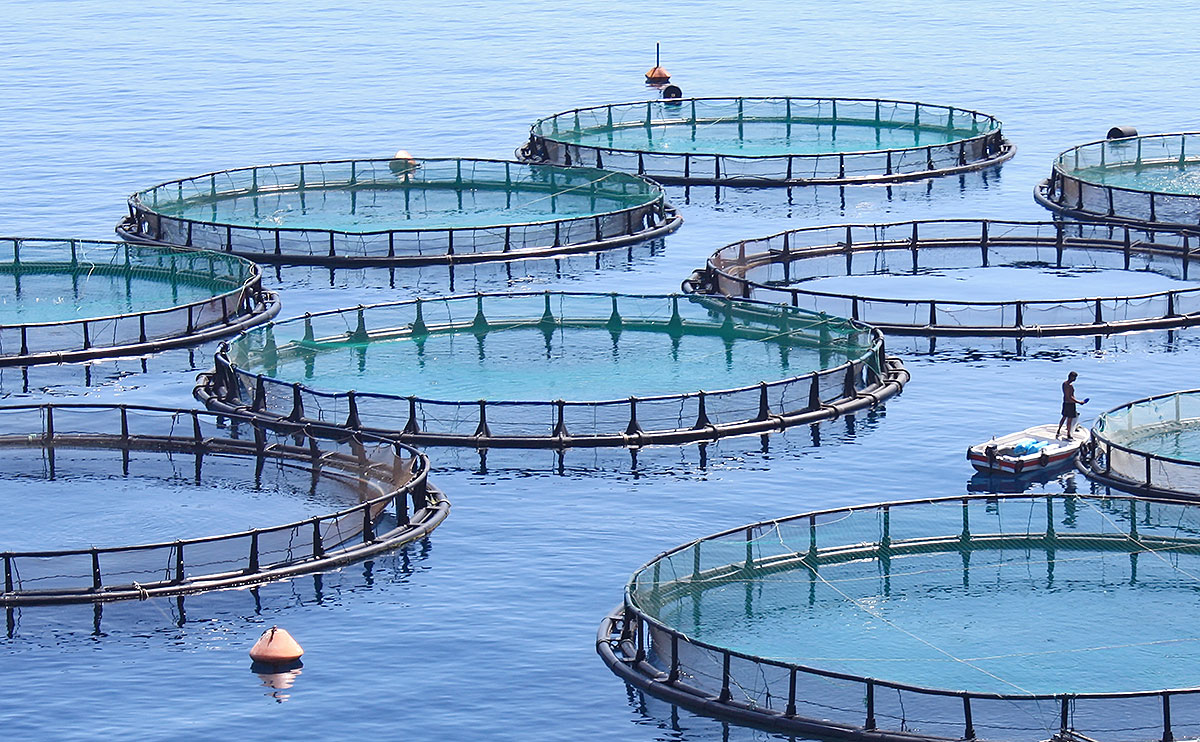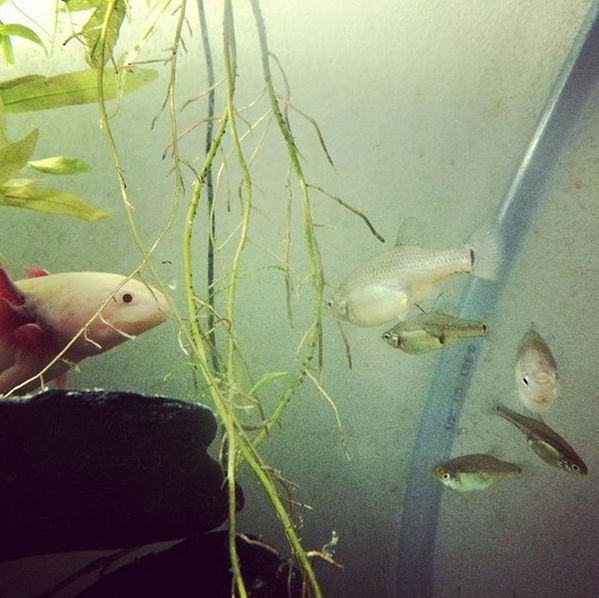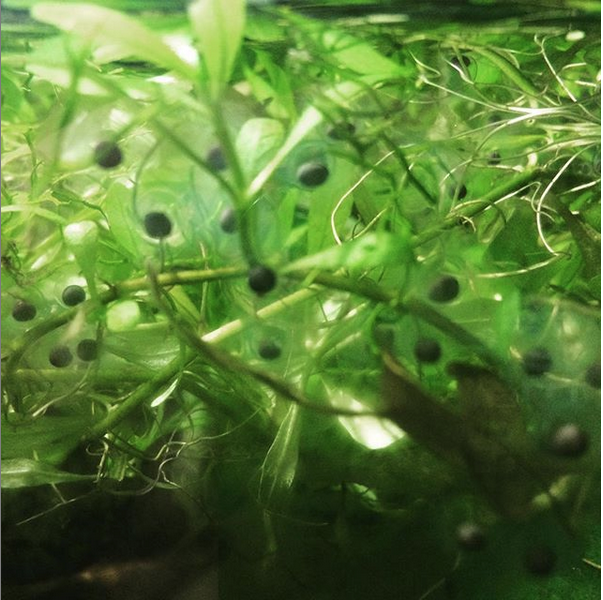Yes, I know they sound like a good match in theory. Guppies are typically considered beginner fish, they’re not super nippy, and they reproduce a lot. Even if your axolotl eats a few, you wouldn’t miss them. Plus they like cooler water than most tropical fish, they can handle the water hardness and just like your axolotl, and they wouldn’t mind a bit of salt.
So what’s the problem, exactly?
The guppies you see in pet stores mainly come from Southeast Asia. A lot of them are grown outdoors, in cage farm systems. The water is on the warmer end of the range guppies can tolerate, and usually brackish, if not full saltwater. Because of the open environment, the fish are exposed to pathogens and parasites that can be transmitted to your axolotl.

This photo shows a wealthier cage farm operation — I’m guessing they’re raising tilapia in there, and the guy on the boat is a company employee, not an independent farmer. Guppy farms tend to be cooperative affairs, with smaller, crowded cages and shoddier installations. Remember, these are being farmed in poorer countries, generally by people who struggle to make ends meet. I’ve watched a presentation from a Thai government official, explaining that guppy farming is such an important part of the economy over there, the government is scrambling to educate farmers about basic sanitation. One common issue they face is contaminated fish food. Contaminated fish food. Being introduced into open bodies of water. Because the farmers are struggling financially, and the fish food directly cuts into their profits, so they’ll use any old crap the fish are likely to eat, even if some of it has been made illegal. Because these are poor people with families to feed, not greedy corporations. They make the least money of anyone involved in this production chain. They are not educated about fish health, or the ecological impacts of what they’re doing.
Of course some of the fish die. It’s not easy to spot and remove them in these kinds of setups. They just get eaten by the herd. And then some more fish die at every step of the process that ensues, which is the government’s main concern. Waste of money, you know?
Here’s what the process looks like: the fish get collected by individual farmers, and dropped of at a transit station. Then they travel some more to get to a larger sorting station, where the fish get separated by sex and colour. Then they’re sent to the transhipper, who organizes the international sales. From there, they’re bagged, sent off to customs, and once they’re cleared for travel, they get shipped overseas. They land in some airport, where they have to clear customs again, and then they’re put on a delivery truck.
By the time they arrive at the wholesaler’s, the fish are hungry and stressed out, and basically not in any condition to withstand sharing their water with a bunch of other random species who have just gone through similar ordeals. But they get put into aquariums that are all connected together anyway, because individual water changes would be a logistical nightmare, and way too time-consuming. The wholesalers would lose money.
So of course, some more fish die. But guppies are hardy, so most make it out okay — enough for the wholesaler to make a profit. Not a lot of profit, but enough to stay in business. Guppies don’t sell for much, but every pet store buys them in large quantities, so they’re pretty much guaranteed to sell out every week.
This means the fish don’t get to stay at the wholesaler’s for long. The sick ones get put down, and the healthy-looking ones get shipped to individual pet stores, where they may or may not get quarantined, or treated with “preventive” medications (often antibiotics, but not the full course, because that would be too expensive.) Then they get displayed along with other fish species. Most pet stores use inline water recirculation systems similar to wholesalers’, because that makes water changes easier and cheaper. So these fish are separated by species, but they’re all passing pathogens back and forth.
Then you come in and buy the fish. You take them home, and let’s be honest, you probably don’t quarantine them, because you don’t have a spare aquarium with a cycled filter, right? Most people don’t. Heck, I’ve skipped quarantine before. (Have I regretted it? Oh yeah.)
But let’s say you’re a smart cookie. Keeping all of the above in mind, you decide to quarantine. You have a nice tank set up just for your new guppies. No heater. Maybe a little salt. And they seem fine! You’re not seeing any signs of illness or any icky worms sticking out of their butts. So after a couple weeks, you add them to your axolotl tank. There’s a sudden increase in the bioload, because you’re adding the new fish all at once, but your axolotl is already a big nitrogen producer, so the ecosystem adjusts.
Here’s the thing. Your axolotl is most comfortable in water that’s somewhere between 16 and 18°C, but can handle higher temperatures, with stress and illness occuring at 22°C and above. Despite what you may have read online, your guppies are most comfortable between 23 and 24°C (references here and here.) They can handle lower temperatures, with stress and illness occuring at 18°C and below (reference here). This means the range at which the two species can comfortably coexist is between 19° and 21°C. That’s not a lot of leeway.
So you aim for a steady 20°C, right? It’s doable, with the right equipment. Except these guppies probably grew up in 26-28°C saltwater, during which time they were exposed to all sorts of pathogens, and they’ve been under a lot of stress for the past one or two months. Asking them to suddenly adapt to cold freshwater is a lot. Listen, I used to live in Florida. It was sweltering hot over there! Then I moved to Canada in the middle of winter. I was sick for two months, and I got frostbite.
And sure, despite all of that, guppies are still a hardy, beginner-friendly fish. Chances are they’ll survive, and unless you’re an experienced fishkeeper, you may not even notice that they were upset for a while. But that’s part of the problem. Because you know who’s not a hardy beginner animal? Your axolotl. Who may or may be eating sick, parasite-infested guppies. This is why I keep saying that the guppy-axolotl combo is best left to experienced aquarists. You need to be able to spot the subtle cues that let you know when something isn’t quite right. You need to be prepared to intervene quickly, you need to know how to treat the most common guppy health issues, and you need to know how to treat your axolotl, too.
“But wait, what if I buy those really expensive guppy strains with carefully selected fin shapes and colour patterns? Surely those weren’t cage farmed and fed contaminated crap?”
You’re right, these fancier strains come from facilities that are often much cleaner, with tightly controlled water parameters, appropriate food, and regular health checks. The problem is, in order to meet the strain’s beauty standards, these fish have to be line bred for several generations. It’s tricky, and more importantly expensive, to line breed in a way that won’t weaken the fish genetically. So while they may leave the facility in peak health conditions, these fish still end up exposed to a lot of the same pathogens as the less carefully raised fish, because they share the same water at the transshipper’s place, then at the wholesaler’s, and then at the pet store. And since the fancier fish are weaker genetically, and never really got the chance to build up strong immune systems by virtue of being raised in clean environments, they are even more likely to get sick than those hardy cage-raised mutts.
Does this mean you have to give up on guppies? Of course not. As people point out to me all the time, the internet is full of axolotl-guppy success stories. How do these people manage it?
The key is to choose guppies who were born and raised in the type of water your axolotl enjoys. How do you find those? Ask around! Some fish stores buy fish from local breeders. Online classifieds are full of people trying to get rid of their extra guppy fry. Most cities have aquarium societies, where fish breeders meet up to share knowledge and hold auctions. Choose a fish that grew up in your water. They’ll be much more likely to stay healthy, and so will your axolotl.
And hey, if all else fails? Get those guppies from the pet store, but give them their own aquarium. Make it comfortable for them, with some salt and the kind of temperatures they prefer. Then once they have babies, move those in with your axolotl. It will be much less of a shock for these second-generation guppies, going from their native environment of 23°C with a tablespoon of aquarium salt, to a 20°C tank with only one teaspoon. And you won’t need to add all of the fish at once, which means your bacteria will find it much easier to adjust.


